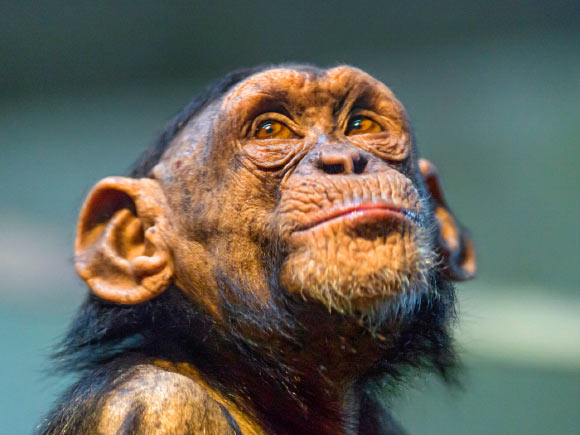Chimpanzees have the same types of smiles as humans when laughing, says a new study published in the journal PLoS ONE. The study also found that chimpanzees are able to produce these smile types silently, without being constrained by the accompanying laughing sound.

A young chimpanzee named Malik at Walter Zoo, Gossau, Switzerland. Image credit: Emmanuel Keller / CC BY-ND 2.0.
The ability to flexibly produce facial expressions and vocalizations has a strong impact on the way humans communicate, but scientists’ understanding of non-human primate facial expressions and vocalizations is limited.
“Humans have the flexibility to show their smile with and without talking or laughing. This ability to flexibly use our facial expressions allows us to communicate in more explicit and versatile ways, but until now we didn’t know chimps could also flexibly produce facial expressions free from their vocalizations,” said Dr Marina Davila-Ross of the University of Portsmouth, UK, lead author on the study.
Dr Davila-Ross and her colleagues investigated whether chimpanzees (Pan troglodytes) produce the same types of facial expressions with and without accompanying vocalizations, as do humans.
They video-recorded 46 chimpanzees at the Chimfunshi Wildlife Orphanage in Zambia and used ChimpFACS – a facial action coding system designed for chimpanzees – to measure the chimps’ facial movements.
“The coding system allows us to examine very subtle facial movements and compare human and chimpanzee facial expressions, based on their shared musculature,” said co-author Prof Kim Bard, also from the University of Portsmouth.
Data showed that chimps produced the same 14 open-mouthed facial expressions when laugh sounds were present as when they weren’t.
Based on the data, the scientists suggest that chimpanzees produce these facial expressions flexibly, without being constrained by the accompanying vocalizations.
Furthermore, the data indicated that the facial expression in addition to vocalization, as well as the facial expression alone, was used differently in social play, for instance, when in physical contact with playmates and when matching playmates’ open-mouthed faces.
The study supports the idea that chimps produce distinctive facial expressions independently from a vocalization, and that their use affects communicative meaning, as both traits are important for a more explicit and versatile way of communicating.
_____
Davila-Ross M et al. 2015. Chimpanzees (Pan troglodytes) Produce the Same Types of ‘Laugh Faces’ when They Emit Laughter and when They Are Silent. PLoS ONE 10 (6): e0127337; doi: 10.1371/journal.pone.0127337







